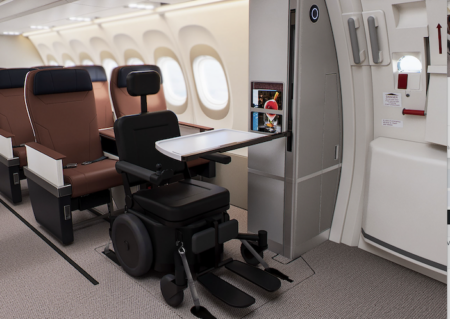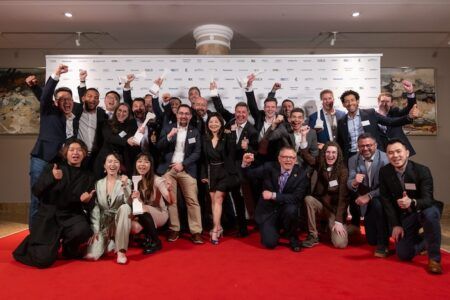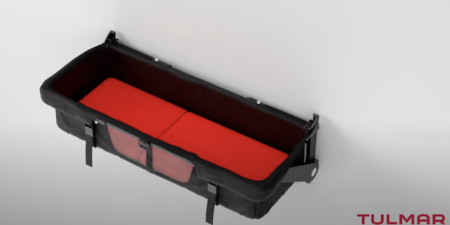Imagine listening to the flight attendant safety briefing with your eyes closed. You can’t see the emergency exits they are pointing out. You don’t know where the masks are dropping down from nor how to fit them on your face. And you just have to imagine what tabs the flight attendants are referring to when they explain how to inflate a life vest. That is the situation thousands of people who are blind or have low vision find themselves in when they fly on commercial aircraft.
Some Alaska Airlines employees took a big step to help the experience recently, when they invited a group of 50 people to visit the carrier’s Seattle maintenance hangar and board a Boeing 737, where they were given specific verbal information and allowed to touch portions of the aircraft not normally available to them. The group included individuals who are blind, have low vision, travelling companions, family members and several service animals.
The group was welcomed by Gary Peterson, an Alaska Airlines maintenance supervisor who has offered similar tours to people with muscular dystrophy for several years. “We want you to feel safe and comfortable flying with us,” Peterson said. “If flying is a barrier for you, hopefully we can take that barrier away. This is going to be a learning experience for us, too.”
While the aircraft never took off, the volunteer flight attendants did their best to simulate a real flight, complete with boarding and disembarking, a safety briefing, inflight announcements, snacks and water service. The passengers also had time to get acquainted with the exterior of the plane and tour the interior from the flight deck to the galley. Flight attendants helped them identify the call button and described how to reach the lavatories. Participants were able to touch and try on safety masks and life vests, and they could also visit the flight deck to feel the controls.
The event came about when Annabelle Fitts of Seattle, who has worked as a teacher and volunteer with people who are blind, asked her Alaska Airlines flight attendant friend Shirley Purkey if arrangements could be made for interested people to have an up close and personal experience on an aircraft. Purkey, who is on Alaska Airlines’ Inclusion Advisory Council, promised to make it happen and received help from Gary Peterson (see above), who is also the chairman of Alaska’s ACCESS [Providing Awareness that Conquers Challenges while Ensuring Safety and Support).
Yang-su Cho, an adaptive technology specialist with the Washington State Department of Services for the Blind, sent out a call for people to attend and dozens responded. While most of the visually impaired people who attended said they’d flown before, they embraced the opportunity to learn more about the aircraft without the pressure of being on an actual flight. Yang-su also assisted Alaska Airlines years ago in setting up computer equipment necessary to hire several individuals who are blind to work in an Alaska Airlines Call Center.
“I think this is wonderful,” said Gloria Walling, the owner/operator of four government cafeterias under the Business Enterprise Program. “I’ve flown before but I’ve never seen an oxygen mask. I want to be able to touch it and try it on and see how it works. I don’t want to have to figure it out in the middle of an accident.”
Another participant, Karen Strudwick of Seattle, said being comfortable with flying is more important than ever as it becomes more routine, and everyone is expected to know the ropes, regardless of their situation. “The training event was among the most useful that I, as a blind person, have ever attended and what I learned, particularly from the hands-on experiences, will be invaluable in my future air travel,” she wrote the next day.
Two women who attended, Jan Hatcher and Julie Harlow, said they have both flown and been treated well but they had a couple of suggestions for any employees who encounter travellers who are blind or have low vision. “One thing that aggravates me is that they always bring a wheelchair. I don’t need a wheelchair. I just need a sighted guide.”
That experience reinforces a common mistake made when working with people who are visually impaired. Employees should always ask if they need help, rather than assuming, Harlow said.
That was a lesson that Julie Mettler, a Seattle-based flight attendant took to heart. “I learned that passengers who are blind, have low vision are more independent than I thought. Flight attendants are so programmed to just help people, I learned that I need to respect their independence and let them tell me how they want to be helped,” Mettler said.
As the evening ended, Purkey said she thought the goal of making customers who are blind, have low vision feel much more secure and comfortable had been achieved. She hopes to schedule future events and also pass some of the lessons learned on through training. “Our customers left feeling confident that they can be more self-sufficient in their travels,” she said. “I had a terrific team of volunteers which made it so successful. We at Alaska learned so much from this event and plan on taking our findings and information to our training department to share with front line employees.”




